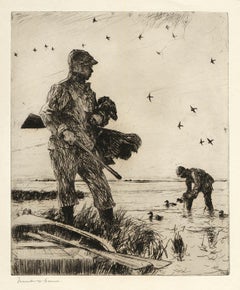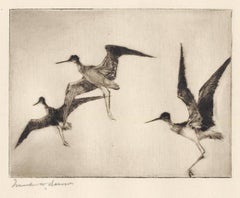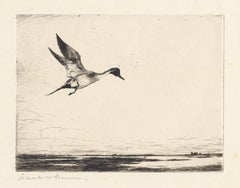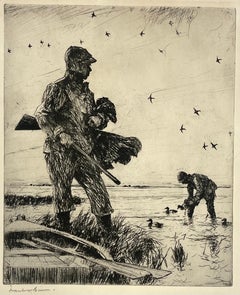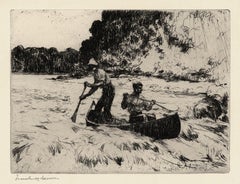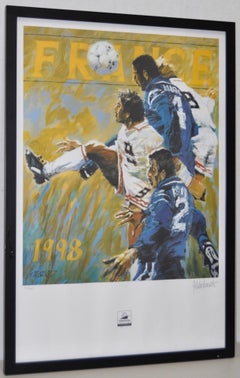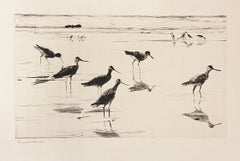Frank Benson Art
American, b. 1978
Born in Salem, Massachusetts, American Impressionist Frank Benson studied at the Museum of Fine Arts in Boston under Otto Grundmann and at the Academie Julian with Gustave Boulanger and Jules Lefebvre. Benson was a founding member of the American Academy of Arts and Letters, Guild of Boston Artists and the ‘Ten American Painters,’ a prestigious group of early impressionists. In 1900, Benson purchased a farm and studio on North Haven Island off the coast of Maine. It was there that his style became increasingly impressionistic. Benson is credited with being known as one of the outstanding 20th-century wildlife printmakers.
Benson was a member of the Boston Art Club, National Academy of Design, Society of American Artists and Guild of Boston Artists. He exhibited at the World’s Columbian Exposition in Chicago, Exposition Universelle in Paris, Lousiana Purchase Exposition in St. Louis and the Panama Pacific Exhibition in San Francisco, as well as at the Art Institute of Chicago, Corcoran Gallery, Carnegie Institute, International and Pennsylvania Academy of Fine Arts. Benson’s works are held in numerous public and private collections, including the National Gallery of Art, Smithsonian American Art Museum, Museum of Fine Arts, Worcester Art Museum and Metropolitan Museum of Art.to
1
11
Overall Width
to
Overall Height
to
12
1
7
1
5
7
5
5
4
2
2
1
1
1
1
1
1
1
1
7
5
5
12
8,816
2,808
1,655
1,313
12
Artist: Frank Benson
Winter Wildfowling
By Frank Benson
Located in New York, NY
This 1927 etching by Frank W. Benson is entitled Winter Wildfowling. Printed in an edition of 150 this impression is signed in pencil, lower left. The image size 11 7/8 x 9 7/8" (30 x 24.8 cm) and sheet size 15 1/16 x 12 5/8" (38.3 x 32 cm).
FRANK W. BENSON (1862-1951)
Frank Weston Benson, well known for his American impressionist paintings, also produced an incredible body of prints - etchings, drypoints, and a few lithographs. Born and raised on the North Shore of Massachusetts, Benson, a natural outdoorsman, grew up sailing, fishing, and hunting. From a young age, he was fascinated with drawing and birding – this keen interest continued throughout his life.
His first art instruction was with Otto Grundman at the Museum of Fine Arts in Boston, and then in 1883 in Paris at the Academie Julian where he studied the rigorous ‘ecole des beaux arts’ approach to drawing and painting for two years.
During the early 1880’s Seymour Haden visited Boston giving a series of lectures on etching. This introduction to the European etching...
Category
1920s American Impressionist Frank Benson Art
Materials
Etching
Study of Turnstones.
By Frank Benson
Located in New York, NY
Frank Benson made this drypoint in 1928. The second state of two.
A scarce print with no recorded printings of the second state - presumably, at least two were printed. The image size is 4 7/8 x 5 7/8" (12.4 x 14.9 cm). #282 in the Frank W. Benson catalogue raisonne by Adam Paff.
Frank Weston Benson (1862-1951), well known for his American impressionist paintings, produced an incredible body of prints - etchings, drypoints, and a few lithographs. Born and raised on the North Shore of Massachusetts, Benson, a natural outdoorsman, grew up sailing, fishing, and hunting. While a teenager his fascination with drawing and birding developed simultaneously and continued throughout his life.
His first art instruction was with Otto Grundman at the Museum of Fine Arts in Boston, and then in 1883 in Paris at the Academie Julian where he studied the rigorous ‘ecole des beaux arts’ approach to drawing and painting for two years.
During the early 1880’s Seymour Haden visited Boston giving a series of lectures on etching. This introduction to the European etching...
Category
Early 20th Century American Realist Frank Benson Art
Materials
Drypoint
Three Yellowlegs.
By Frank Benson
Located in New York, NY
The drypoint created in 1920 is a working state, the fourth of eight. The eight states are listed in the Frank W. Benson catalogue raisonne by Adam Paff #184. There are two recorded impressions of this print making it a rare find. It is signed in pencil and inscribed "D-2." The Image size 4 3/8 x 5 13/16" (11.1 x 14.8 cm). The final printed edition of "Three Yellowlegs" was 150.
Frank Weston Benson (1862-1951), well known for his American impressionist paintings, produced an incredible body of prints - etchings, drypoints, and a few lithographs. Born and raised on the North Shore of Massachusetts, Benson, a natural outdoorsman, grew up sailing, fishing, and hunting. While a teenager his fascination with drawing and birding developed simultaneously and continued throughout his life.
His first art instruction was with Otto Grundman at the Museum of Fine Arts in Boston, and then in 1883 in Paris at the Academie Julian where he studied the rigorous ‘ecole des beaux arts’ approach to drawing and painting for two years.
During the early 1880’s Seymour Haden visited Boston giving a series of lectures on etching. This introduction to the European etching...
Category
Early 20th Century American Realist Frank Benson Art
Materials
Drypoint
Lone Pintail.
By Frank Benson
Located in New York, NY
This drypoint from 1930 was printed in an edition of 150. It is signed in pencil just under the image in the lower left. Listed in the catalogue raisonne on Frank W. Benson by Adam Paff #303.
Frank Weston Benson (1862-1951), well known for his American impressionist paintings, produced an incredible body of prints - etchings, drypoints, and a few lithographs. Born and raised on the North Shore of Massachusetts, Benson, a natural outdoorsman, grew up sailing, fishing, and hunting. While a teenager his fascination with drawing and birding developed simultaneously and continued throughout his life.
His first art instruction was with Otto Grundman at the Museum of Fine Arts in Boston, and then in 1883 in Paris at the Academie Julian where he studied the rigorous ‘ecole des beaux arts’ approach to drawing and painting for two years.
During the early 1880’s Seymour Haden visited Boston giving a series of lectures on etching. This introduction to the European etching...
Category
1930s American Realist Frank Benson Art
Materials
Drypoint
WINTER WILDFOWLING
By Frank Benson
Located in Portland, ME
Benson, Frank. WINTER WILDFOWLING. Etching, 1927. Paff 265. Edition of 150. Signed in pencil, lowwer left. 11 7/8 x 9 7/8 inches (plate), 14 1/2 x 12 1/2 inches (sheet). Printed on W...
Category
1920s Frank Benson Art
Materials
Etching
Running the Rapids
By Frank Benson
Located in New York, NY
The etching "Running the Rapids" was created by Frank Benson in 1927. Printed in an edition of 150, this impression is signed in pencil, lower left. The image size is 5 13/16 x 7 7/8" (14.8 x 20 cm) and sheet size 8 1/16 x 10 5/16" (20.3 x 26.2 cm).
Frank Weston Benson (1862-1951), well known for his American impressionist paintings, also produced an incredible body of prints - etchings, drypoints, and a few lithographs. Born and raised on the North Shore of Massachusetts, Benson, a natural outdoorsman, grew up sailing, fishing, and hunting. From a young age, he was fascinated with drawing and birding – this keen interest continued throughout his life.
His first art instruction was with Otto Grundman at the Museum of Fine Arts in Boston, and then in 1883 in Paris at the Academie Julian where he studied the rigorous ‘ecole des beaux arts’ approach to drawing and painting for two years.
During the early 1880’s Seymour Haden visited Boston giving a series of lectures on etching. This introduction to the European etching...
Category
1920s American Impressionist Frank Benson Art
Materials
Etching
On the Kedgwick
By Frank Benson
Located in New York, NY
Frank Benson created the etching "On the Kedgwick" in 1923, in an edition of 150. This impression is the second state of four. There are five known impressions of the second state. It is signed in pencil and inscribed "B-1" and "1 or 5" at the lower left paper edge (pencil). The image size 7 13/16 x 11 7/8" (19.9 x 30.2 cm) and sheet size 15 3/8 x 11 1/2" )29.3 x 39 cm). It is listed in the Frank W. Benson catalogue raisonne by Paff #222.
FRANK W. BENSON (1862-1951)
Frank Weston Benson, well known for his American impressionist paintings, also produced an incredible body of prints - etchings, drypoints, and a few lithographs. Born and raised on the North Shore of Massachusetts, Benson, a natural outdoorsman, grew up sailing, fishing, and hunting. From a young age, he was fascinated with drawing and birding – this keen interest continued throughout his life.
His first art instruction was with Otto Grundman at the Museum of Fine Arts in Boston, and then in 1883 in Paris at the Academie Julian where he studied the rigorous ‘ecole des beaux arts’ approach to drawing and painting for two years.
During the early 1880’s Seymour Haden visited Boston giving a series of lectures on etching. This introduction to the European etching...
Category
1920s Impressionist Frank Benson Art
Materials
Etching
RUNNING THE RAPIDS
By Frank Benson
Located in Portland, ME
Benson, Frank. RUNNING THE RAPIDS. Paff 269. Etching, 1927. Edition of 150. Signed in pencil. Printed on Whatman paper. 5 7/8 x 7 3/4 inches (plate), 8 1/2 x 10 5/8 inches (sheet). A...
Category
1920s American Realist Frank Benson Art
Materials
Etching
The Punter
By Frank Benson
Located in New York, NY
A superb, richly-inked impression of this etching. Edition of 150. Signed in pencil, lower left.
Category
1920s American Impressionist Frank Benson Art
Materials
Etching
The Bridge
By Frank Benson
Located in New York, NY
"The Bridge" is a drypoint by Frank Benson created in 1923. Printed in an edition of 150 this impression is signed in pencil, lower left. The image size is 13 1/2 x 10 5/8" (34.2 x 26.8 cm) and sheet size 16 1/2 x 13 1/16" (41.8 x 33.3 cm).
FRANK W. BENSON (1862-1951)
Frank Weston Benson, well known for his American impressionist paintings, also produced an incredible body of prints - etchings, drypoints, and a few lithographs. Born and raised on the North Shore of Massachusetts, Benson, a natural outdoorsman, grew up sailing, fishing, and hunting. From a young age, he was fascinated with drawing and birding – this keen interest continued throughout his life.
His first art instruction was with Otto Grundman at the Museum of Fine Arts in Boston, and then in 1883 in Paris at the Academie Julian where he studied the rigorous ‘ecole des beaux arts’ approach to drawing and painting for two years.
During the early 1880’s Seymour Haden visited Boston giving a series of lectures on etching. This introduction to the European etching...
Category
1920s American Impressionist Frank Benson Art
Materials
Drypoint
THE BRIDGE
By Frank Benson
Located in Portland, ME
Benson, Frank. THE BRIDGE. Paff 227. Drypoint on copper, 1923. A trial proof of the second state, printed on uncalendared Japanese Vellum, annotated "B-1," the first of two trial pro...
Category
20th Century American Realist Frank Benson Art
Materials
Drypoint
MARSH GUNNER
By Frank Benson
Located in Portland, ME
Benson, Frank. MARSH GUNNER. Paff 149. Etching, 1918. Edition of 150. Signed in pencil, lower left, and numbered "93" in pencil, lower right. 10 7/8 x 8 7/8 inches (plate), 15 3/4 x ...
Category
1910s Frank Benson Art
Materials
Etching
Related Items
Original Nice-Themal spa Berthemont - Les -Bains antique French vintage poster
By Emmanuel Bellini
Located in Spokane, WA
Original French travel poster: Nice - Thermal health spa original vintage poster created by artist Emmanuel Bellini.
Original linen backed, large French travel size: Nice - Therm...
Category
1950s Impressionist Frank Benson Art
Materials
Lithograph
$995
H 47 in W 32 in D 0.07 in
France World Cup Lithograph by Aldo Luongo c.1998
By Aldo Luongo
Located in San Francisco, CA
FRANCE World Cup Lithograph by Aldo Luongo c.1998
Limited edition France 98' World Cup - Official License
From a very limited edition of 300.
Pencil signed lower right. Edition 24/300 lower left.
This is a rare, very small edition lithograph for the 1998 Soccer World Cup...
Category
Late 20th Century Impressionist Frank Benson Art
Materials
Lithograph
Salvador Dali Pencil Signed Nude on a Rhinoceros Horn
By Salvador Dalí
Located in San Francisco, CA
Salvador Dali: 1904-1989. One of the most famous artist of the 20th century. A master surrealist, whose auction prices are well into the millions. This image of a nude on a rhinocero...
Category
Mid-20th Century Surrealist Frank Benson Art
Materials
Etching
Leonor Fini - Cats - Original Etching
By Leonor Fini
Located in Collonge Bellerive, Geneve, CH
Leonor Fini - Cats - Original Engraving
Mme.Helvetius' Cats
Original etching created in 1985, Printed Signature (LF).
Conditions: excellent
Edition: 100
Support: Arches paper.
Dimensions: Paper dimensions: 44 x 28 cm
Editions: Moret, Paris.
Leonor Fini is considered one of the most important women artists of the mid-twentieth century, along with Leonora Carrington, Frida Kahlo, Meret Oppenheim, Remedios Varo, and Dorothea Tanning – most of whom Fini knew well. Her career, which spanned some six decades, included painting, graphic design, book illustration, product design (the renowned torso-shaped perfume bottle for Schiaparelli’s Shocking), and set and costume design for theatre, ballet, opera, and film. In this compellingly readable, exhaustively researched account, author Peter Webb brings Fini’s provocative art and unconventional personal life, as well as the vibrant avant-garde world in which she revolved, vividly in life.
Born in Buenos Aires in 1907 (August 30 – January 18, 1996, Paris) to Italian and Argentine parents, Leonor grew up in Trieste, Italy, raised by her strong-willed, independent mother, Malvina. She was a virtually self-taught artist, learing anatomy directly from studying cadavers in the local morgue and absorbing composition and technique from the Old Masters through books and visits to museums.
Fini’s fledging attempts at painting in Trieste let her to Milan, where she participated in her first group exhibition in 1929, and then to Paris in 1931.
Her vivacious personality and flamboyant attire instantly garnered her a spotlight in the Parisian art world and she soon developed close relationships with the leading surrealist writers and painters, including Paul Eluard, Salvador Dali, Man Ray, and Max Ernst, who became her lover for a time. The only surrealist she could not abide because of his misogyny was André Breton. Although she repeatedly exhibited with them, she never considered herself a surrealist. The American dealer Julien Levy,
very much impressed by Fini’s painting and smitten by her eccentric charms, invited her to New York in 1936, where she took part in a joint gallery exhibition with Max Ernst and met many American surrealists, including Joseph Cornell and Pavel Tchelitchew. Her work was included in MoMA’s pivotal Fantastic Art, Dada and Surrealism exhibition, along with De Chirico, Dali, Ernst, and Yves Tanguy.
In 1939 in Paris she curated an exhibition of surrealist furniture for her childhood friend Leo Castelli for the opening of his first gallery.
Introductions to her exhibition catalogues were written by De Chirico, Ernst, and Jean Cocteau.
A predominant theme of Fini’s art is the complex relationship between the sexes, primarily the interplay between the dominant female and the passive, androgynous male. In many of her most powerful works, the female takes the form of a sphinx, often with the face of the artist. Fini was also an accomplished portraitist; among her subjects were Stanislao Lepri...
Category
1980s Modern Frank Benson Art
Materials
Etching
Le Demon Ailé - Etching and Drypoint - 1969
By Salvador Dalí
Located in Roma, IT
Le demon Ailé is a wonderful black and white drypoint realized in 1969.
The artwork is from the portfolio "Vénus aux fourrures", edited by Pierre Argillet, Parigi, 1969.
Hand signed in pencil by the artist on the lower margin. Dry stamp on the lower right margin
Numbered on the lower left margin. Ed.21/75.
Good conditions except for some light yellowing of paper along the margin.
Ref: Michler Lopsinger, "Salvador Dali Catalogue Raisonne of Etchings and Mixed-Media Prints 1924-1980", Prestel 1994, n. 371.
Salvador Dalí (Figueres, 1904 – Figueres, 1989) is considered one of the most versatile and prolific artists of the XX century and the founding father of Surrealism. In the course of his long career, he successfully experimented with sculpture, fashion, writing, and filmmaking. Dalí epitomizes the idea that life is the greatest form of art; André Breton said about him: “It is with Dalí that, for the very first time, the windows of the mind are wide open”.
He always pushed boundaries, and he did the same with conventional lithography. He experimented a lot, also with techniques that would not be allowed today. He was a prolific printmaker, using techniques as drypoint, etching, woodcut and lithography. His output is esteemed at 1700 prints...
Category
1960s Surrealist Frank Benson Art
Materials
Drypoint, Etching
Old Rinkrank threatens the Princess by David Hockney Brothers Grimm Fairy Tales
By David Hockney
Located in New York, NY
This etching from David Hockney’s celebrated Six Fairy Tales from the Brothers Grimm portfolio depicts the somewhat obscure story Old Rinkrank, which Hockney chose to illustrate beca...
Category
1960s Modern Frank Benson Art
Materials
Etching, Aquatint
Birds - XXI century, Figurative print, Black and white, Animals
By Anna Mikke
Located in Warsaw, PL
Limited edition, 8/10. ANNA MIKKE (born in 1950) She graduated from the Academy of Fine Arts in Łódź in 1975. After graduation, she was engaged in graphic design, including designing...
Category
2010s Other Art Style Frank Benson Art
Materials
Paper, Etching
$177
H 4.73 in W 10.04 in
Salvador Dali - The Oak and the Reed - Signed Engraving
By Salvador Dalí
Located in Collonge Bellerive, Geneve, CH
SALVADOR DALI
The Oak and the Reed (La chêne et le roseau) from Le Bestiaire de la Fontaine
1974
Hand signed by Dali
Edition: /250
Conditions: A small tear defect has been restaured...
Category
1970s Surrealist Frank Benson Art
Materials
Drypoint, Aquatint
$2,134
H 29.93 in W 22.84 in D 0.04 in
Original American Graffiti Italian vintage movie poster
Located in Spokane, WA
Original Italian movie poster: American Graffiti - Italian style. Anche Tu negli anne '60's Linen-backed offset lithograph. A great George Lucas film. American Graffiti, voted in 1998 to the American Film Institute's list of 100 superlative films. This one should be in your collection. This original Italian size (39.5" x 54.75') is ready to frame. Original movie poster theatrical issued fold marks restored during linen backing. Overall condition is very good with very minor printing flaws.
The vintage poster features a silhouette of a football jersey with a big glass of Coca-Cola balanced as the head of the image. This was a George Lucas film with Richard Dreyfuss and Ron Howard. A Francis Ford Coppola production.
This is a genuine Italian one-sheet ORIGINAL MOVIE POSTER issued by the studio when the film was released and meant for theatrical display. (Italian posters of this size may also be referred to as a 2-sheet because of their size; it is, however, printed on a single sheet.) a.k.a. (an Italian duo foglio.)
This is an Original Lithograph Vintage Italian Poster...
Category
1970s American Impressionist Frank Benson Art
Materials
Offset
$396 Sale Price
20% Off
H 54.4 in W 39.5 in D 0.05 in
Daniel in the Lions' Den
Located in New York, NY
Ukrainian-born, lower East Side based, Sarah Berman was active on the NYC-WPA and in artists' circles. Daniel in the Lions' Den is an etching, signed and ...
Category
1930s Ashcan School Frank Benson Art
Materials
Etching
Engraving #1 by Ernst Fuchs: KABBALAH (SEFER YETSIRA and 32 PATHS OF WISDOM)
By Ernst Fuchs
Located in Cliffside Park, NJ
Original engraving #7 by Ernst FUCHS from Kabbalah (THIRTY-TWO PATHS OF WISDOM by SEFER YETZIRA), 1978
Etching signed and numbered 16/30 E.A.
Page size - 30 ...
Category
1970s Modern Frank Benson Art
Materials
Paper, Etching
"The Lithographs and Etchings of Philip Pearlstein"
By Philip Pearlstein
Located in New York, NY
Philip Pearlstein
"The Lithographs and Etchings of Philip Pearlstein"
Boston University Art Gallery, 1979
Exhibition poster
25 x 32.5 inches
Signed recto
Category
1970s American Realist Frank Benson Art
Materials
Offset
Previously Available Items
"Goose and Teal, " etching, Frank Benson, in collections of Met, MFA, Smithsonian
By Frank Benson
Located in Wiscasset, ME
Born in Salem, Massachusetts, American Impressionist Frank Benson studied at the Museum of Fine Arts in Boston under Otto Grundmann and at the Academie Julian with Gustave Boulanger and Jules Lefebvre. Benson was a founding member of the American Academy of Arts and Letters, Guild of Boston Artists and the ‘Ten American Painters,’ a prestigious group of early impressionists. In 1900, Benson purchased a farm and studio on North Haven Island off the coast of Maine. It was there that his style became increasingly impressionistic. Benson is credited with being known as one of the outstanding 20th-century wildlife printmakers.
Benson was a member of the Boston Art Club, National Academy of Design, Society of American Artists and Guild of Boston Artists. He exhibited at the World’s Columbian Exposition in Chicago...
Category
Early 20th Century American Impressionist Frank Benson Art
Materials
Etching
WADERS
By Frank Benson
Located in Portland, ME
Benson, Frank (American, 1862-1951). WADERS. Paff 298. Drypoint, printed on wove paper, 1930. Edition of 150. Signed in pencil. 7 x 12 inches, 176 x 304 mm. Provenance: Descended wit...
Category
1930s Frank Benson Art
Materials
Drypoint
WINTER WILDFOWLING
By Frank Benson
Located in Santa Monica, CA
FRANK WESLEY BENSON (1862 - 1951)
WINTER WILDFOWLING, 1927 (PAFF 265)
Etching, Signed in pencil. Edition 150. 11 7/8 X 9 7/8 inches. Sheet 14 3/4 x 12 1/4 with full margins with de...
Category
1920s Impressionist Frank Benson Art
Materials
Etching
Ducks in the Rain
By Frank Benson
Located in Santa Monica, CA
FRANK BENSON (1862-1951)
DUCKS IN THE RAIN, 1918 (Paff 147)
Etching, signed in pencil. Edition 100, with a no. 9. Unidentified Collector's mark CTB. Image, 8 x 6 inches, sheet 12 1...
Category
1910s American Impressionist Frank Benson Art
Materials
Etching
DORY FISHERMAN
By Frank Benson
Located in Portland, ME
Benson, Frank. DORY FISHERMAN. Paff 267. Etching, 1927. Edition of 150, signed in pencil, lower left. Printed on Whatman laid paper. 7 3/4 x 9 7/8 inches (plate) 11 x 13 inches (shee...
Category
1920s Frank Benson Art
Materials
Etching
YELLOWLEGS IN SUNLIGHT
By Frank Benson
Located in Portland, ME
Benson, Frank. YELLOWLEGS IN SUNLIGHT. Paff 285. Drypoint, 1928. Published state, Edition of 150. Printed on laid paper watermarked "England." Provenance, the family of the artist. 9...
Category
1920s Frank Benson Art
Materials
Drypoint
SPRIGTAIL
By Frank Benson
Located in Portland, ME
Benson, Frank. SPRIGTAIL. Pfaff 151. Etching, 1918. Edition of 50. Signed in pencil. 4 x 5 inches, plate. Framed to 9 7/8 x 12 inches. In excellent condition.
Category
1910s Frank Benson Art
Materials
Etching
DUCK BLIND
By Frank Benson
Located in Portland, ME
Benson, Frank W.
DUCK BLIND. Paff, 245.
Etching, 1925.
Edition of 150.
7 7/8 x 10 7/8 inches; 197 x 275 mm.
Signed in pencil.
A rich, dark impression.
Category
1920s Frank Benson Art
Materials
Etching
Geese Drifting Down.
By Frank Benson
Located in New York, NY
This etching by Frank Benson was made in 1929 in an edition of 150. Signed in pencil under the image in the lower left. It is the fifth state of five. Image size 8 7/8 x 14" (22.1 x 35.1 cm). Printed on Whatman paper.
Frank Weston Benson (1862-1951), well known for his American impressionist paintings, produced an incredible body of prints - etchings, drypoints, and a few lithographs. Born and raised on the North Shore of Massachusetts, Benson, a natural outdoorsman, grew up sailing, fishing, and hunting. While a teenager his fascination with drawing and birding developed simultaneously and continued throughout his life.
His first art instruction was with Otto Grundman at the Museum of Fine Arts in Boston, and then in 1883 in Paris at the Academie Julian where he studied the rigorous ‘ecole des beaux arts’ approach to drawing and painting for two years.
During the early 1880’s Seymour Haden visited Boston giving a series of lectures on etching. This introduction to the European etching...
Category
Early 20th Century American Realist Frank Benson Art
Materials
Etching
Dory Fisherman.
By Frank Benson
Located in New York, NY
This etching was made in 1927 and printed in an edition of 150. It is signed in the lower left under the image. Later inscribed "To Lucien Price -1943-."
Frank Weston Be...
Category
Early 20th Century American Realist Frank Benson Art
Materials
Etching
Canoeman.
By Frank Benson
Located in New York, NY
Frank Benson made this etching in 1919. An avid outdoorsman, Benson's outings directly inspired much of his graphic work. Printed in an edition of 150. Signed in pencil. The imag...
Category
Early 20th Century American Realist Frank Benson Art
Materials
Etching
Duck in Flight
By Frank Benson
Located in Wiscasset, ME
Born in Salem, Massachusetts, American Impressionist Frank Benson studied at the Museum of Fine Arts in Boston under Otto Grundmann and at the Academie Julian with Gustave Boulanger and Jules Lefebvre. Benson was a founding member of the American Academy of Arts and Letters, Guild of Boston Artists and the 'Ten American Painters,' a prestigious group of early impressionists. In 1900, Benson purchased a farm and studio on North Haven Island off the coast of Maine. It was there that his style became increasingly impressionistic. Benson is credited with being known as one of the outstanding 20th-century wildlife printmakers.
Benson was a member of the Boston Art Club, National Academy of Design, Society of American Artists and Guild of Boston Artists. He exhibited at the World’s Columbian Exposition in Chicago...
Category
Early 20th Century Impressionist Frank Benson Art
Materials
Etching
Frank Benson art for sale on 1stDibs.
Find a wide variety of authentic Frank Benson art available for sale on 1stDibs. You can also browse by medium to find art by Frank Benson in etching, drypoint, engraving and more. Much of the original work by this artist or collective was created during the 20th century and is mostly associated with the Impressionist style. Not every interior allows for large Frank Benson art, so small editions measuring 12 inches across are available. Customers who are interested in this artist might also find the work of Gene Kloss, Louis Oscar Griffith, and Childe Hassam. Frank Benson art prices can differ depending upon medium, time period and other attributes. On 1stDibs, the price for these items starts at $1,200 and tops out at $11,700, while the average work can sell for $4,400.
